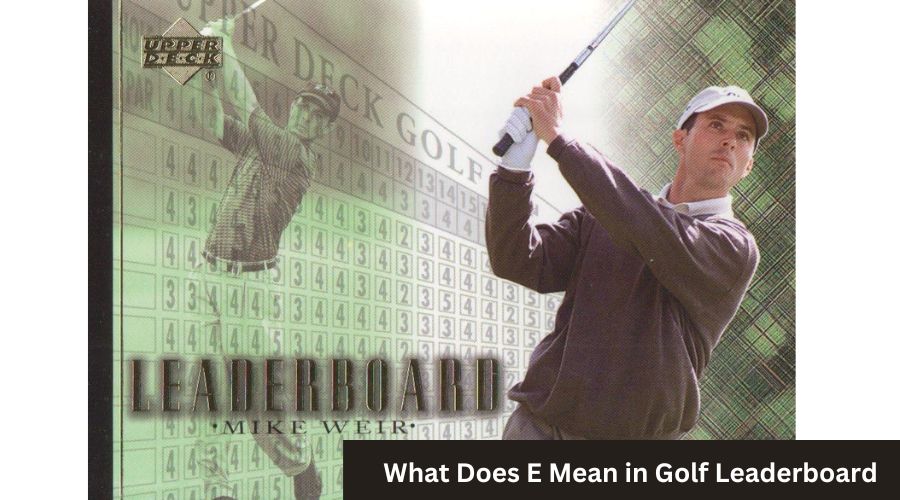In golf, the letter “E” stands for “even par,” indicating that the player’s score matches the standard score. When a golfer achieves even par, it means they have completed the round using an equal number of strokes as the combined par of all the holes.
This is a significant achievement in golf, and understanding the concept of “even par” is essential for interpreting golf leaderboards and scores. With “E” representing even par, it signifies the level of skill and precision required to reach this scoring milestone.
As we delve into the intricacies of golf scoring, it becomes evident that “even par” holds a special place in the sport, representing a balanced performance on the course. Understanding the significance of “E” on a golf leaderboard enhances the appreciation for the skill and strategy involved in the game.
Contents
- 1 Decoding The ‘e’ On The Golf Leaderboard
- 2 Par: The Benchmark Of The Course
- 3 Scoring Terms Every Golfer Should Know
- 4 Leaderboard Symbols And Their Meanings
- 5 The Language Of Golf Scores
- 6 How Players Achieve Even Par
- 7 Impact Of Par On Tournament Outcomes
- 8 Understanding Golf Handicap Symbols
- 9 Frequently Asked Questions
- 10 Conclusion
Decoding The ‘e’ On The Golf Leaderboard
When you see an ‘E’ on the Golf Leaderboard, it signifies ‘Even Par’, indicating the player scored exactly the standard par. This term is used when the number of strokes taken equals the course’s par, showing a balanced performance.
The Meaning Of ‘e’ In Golf Scoring
Decoding the ‘E’ on the golf leaderboard can be confusing for those who are not familiar with golf scoring. In golf, ‘E’ stands for even par, which means that the golfer has completed the round in the same number of strokes as the combined par of all holes.Even Par Explained
To understand even par better, let’s take an example. If the par for a round is 72, and a golfer completes the round in 72 strokes, then the golfer’s score would be even par, which is represented as ‘E’ on the leaderboard. Similarly, if a golfer completes the round in 70 strokes, the golfer’s score would be two under par, which is represented as ‘-2’ on the leaderboard. It’s important to note that ‘E’ on the leaderboard doesn’t necessarily mean that the golfer has played a perfect round. It simply means that the golfer has completed the round in the same number of strokes as the combined par of all holes. In conclusion, ‘E’ on the golf leaderboard stands for even par, which means that the golfer has completed the round in the same number of strokes as the combined par of all holes.Par: The Benchmark Of The Course
How par is determined for a golf course:
Par in golf is determined based on the number of strokes an expert golfer is expected to make on each hole. This calculation considers factors like distance, hazards, and green conditions.
The role of par in scoring:
- Par sets the standard for each hole, defining the number of strokes a skilled golfer should take.
- Matching par indicates the player is performing at an expected level, denoted by the letter “E” for even par.
- Above par scores are marked with a plus sign, while below par scores are indicated by a minus sign.
Scoring Terms Every Golfer Should Know
Understanding the scoring terms used in golf is essential for any golfer. Whether you’re a beginner or a seasoned player, knowing the significance of terms like birdies, bogeys, and eagles can greatly enhance your golfing experience and help you track your progress effectively.
Birdies
A birdie in golf refers to completing a hole in one stroke less than par. For example, scoring a 3 on a par 4 hole is considered a birdie. It’s a coveted achievement and indicates skill and precision in your game.
Bogeys
Conversely, a bogey occurs when a hole is completed in one stroke more than par. For instance, scoring a 5 on a par 4 hole is a bogey. While bogeys are generally viewed less favorably than birdies, they are an inevitable part of the game for most golfers.
Eagles
An eagle is achieved when a hole is completed two strokes less than par. For example, scoring a 2 on a par 4 hole is an eagle. It’s a remarkable feat and a rare occurrence for many golfers, often eliciting a sense of accomplishment and excitement.
Understanding these scoring terms not only allows you to accurately interpret a golf leaderboard but also provides valuable insight into your performance on the course. Next time you see these terms on a leaderboard, you’ll have a deeper appreciation for the skill and precision required to achieve them.
Leaderboard Symbols And Their Meanings
The letter “E” on a golf leaderboard signifies “even par,” indicating a player’s score matches the standard par. This term is used when a golfer completes a round with the same number of strokes as the combined par of all holes.
Interpreting Circles, Squares, And Numbers
When observing a golf leaderboard, the symbols and numbers can provide valuable insights into a player’s performance. Let’s delve into the meanings of these symbols to better understand the leaderboard.
Different Leaderboard Formats
Golf leaderboards can vary in format, and it’s essential to comprehend the different representations to interpret the scores accurately.
When you encounter circles, squares, and numbers on a golf leaderboard, here’s what they typically signify:
- Circles: A circle next to a player’s name indicates that they are even par, meaning their score matches the standard par for the course.
- Squares: In some leaderboards, squares might be used to denote a specific status or condition, such as a special achievement or a player’s position in the tournament.
- Numbers: The numbers displayed alongside players’ names represent their score relative to par. Negative numbers denote scores below par, while positive numbers indicate scores above par.
When it comes to different leaderboard formats, some may use color coding to represent scores:
| Color | Meaning |
|---|---|
| Red | Under-par scores |
| Green | Over-par scores |
| Green zeroes | Even par |
The Language Of Golf Scores
In golf, the letter “E” stands for “even” or “even par” on the leaderboard. It indicates that the player’s score is exactly equal to the par score for the course. For example, if a golfer completes a round with a score of 72 on a par 72 course, their score would be listed as “E.
“
Golf’s Unique Scoring Vocabulary
Golf has a unique scoring vocabulary that includes various terms and symbols, each with its own specific meaning. Understanding this golf-specific language is crucial for anyone interested in the sport.
Learning Golf Scoring Language
When it comes to golf scoring, the term “E” on a leaderboard stands for “Even Par.” This means the player has completed the round with a score equal to the expected number of strokes for the course. It signifies a balanced performance, with the player neither under nor over par.
Learning the language of golf scoring involves familiarizing oneself with terms such as birdie, bogey, eagle, and albatross, each representing specific scores relative to par for a hole. Additionally, understanding the significance of numbers and letters on a golf leaderboard is essential for following the progress of players during a tournament.
Ensuring each H3 heading adheres to HTML syntax.
How Players Achieve Even Par
Strategies For Maintaining Even Par
Players can achieve even par by employing a variety of strategies throughout their game. These may include:
- Consistent ball striking and accurate approach shots
- Strategic course management to avoid hazards and difficult lies
- Effective putting and short game skills to save pars and minimize bogeys
- Staying mentally focused and maintaining composure under pressure
Challenges In Achieving ‘e’
Attaining even par in golf comes with its own set of challenges, such as:
- Dealing with unpredictable weather conditions that can affect ball flight and distance control
- Navigating difficult pin positions and undulating greens
- Managing the mental aspect of the game, especially when facing high-stress situations
- Adapting to changes in course conditions and adjusting game plan accordingly
Impact Of Par On Tournament Outcomes
Understanding the impact of par on tournament outcomes is essential in golf. The “E” on the leaderboard indicates that a player has scored even par, meaning they have exactly the par score. This can significantly influence the overall standings and player performance.
Par’s Influence On Competitive Play
Par plays a significant role in determining tournament outcomes.
Players strive to match or beat par on each hole to stay competitive.
Famous Rounds At Even Par
Even par rounds are highly regarded in golf history.
Players achieving even par demonstrate exceptional skill and consistency.
At tournaments, scoring ‘E’ signifies achieving par on all holes.
Players aim for ‘E’ to stay on track for a competitive performance.
Understanding the impact of par is crucial for golfers seeking success.
Matching or beating par can lead to victory in golf tournaments.
Understanding Golf Handicap Symbols
In golf leaderboards, ‘E’ signifies even par, indicating the player scored exactly at par. This term is used when the number of strokes matches the standard score, illustrating a balanced performance.
Deciphering The Handicap Alphabet Soup
If you’re new to golf, the handicap system can seem like an alphabet soup. There are terms like E, +, -, and T that appear on scoreboards and leaderboards. What do they mean? Let’s start with E. In golf, the term “handicap” refers to a number that represents a golfer’s skill level. It is calculated based on the average of a golfer’s best scores and is designed to allow players of different skill levels to compete fairly against each other. The handicap system is denoted by a variety of symbols, including letters and numbers. These symbols are used to indicate a golfer’s score relative to par. Understanding these symbols is important for anyone who wants to follow golf or play the game competitively.What Does E Mean In Golf Leaderboard?
When you see the letter E next to a golfer’s name on a leaderboard, it means that they are playing at even par. This means that they have completed the course in the same number of strokes as the course’s par rating. For example, if a course has a par rating of 72, and a golfer completes the course in 72 strokes, they are said to be playing at even par, or E. If they complete the course in 71 strokes, they are playing at one stroke under par, denoted by a “-1”. If they complete the course in 73 strokes, they are playing at one stroke over par, denoted by a “+1”.How Handicaps Relate To Even Par
A golfer’s handicap is used to adjust their score for the purpose of competing against other golfers of different skill levels. For example, if a golfer with a handicap of 10 completes a course in 82 strokes, their net score would be 72 (82 strokes – 10 handicap), which is even par for a course with a par rating of 72. The handicap system allows golfers of different skill levels to compete on a level playing field. By adjusting scores based on a golfer’s handicap, the system ensures that each golfer’s score reflects their true skill level, regardless of the difficulty of the course they are playing. In conclusion, understanding golf handicap symbols is important for anyone who wants to follow golf or play the game competitively. The letter E on a leaderboard indicates that a golfer is playing at even par, while a golfer’s handicap is used to adjust their score for the purpose of competing against other golfers of different skill levels.Frequently Asked Questions
What Does E Mean In A Golf Score?
In golf, “e” on a scorecard stands for even par, indicating the player has matched the standard score.
What Does F Mean On Pga Leaderboard?
The letter F on the PGA leaderboard stands for “Finished. ” It indicates that the player has completed their round and their final score has been recorded.
What Does E Stand For In Disc Golf?
In disc golf, “E” stands for even par, which means the player’s score matches the standard score.
What Does The T Stand For In Golf Leaderboards?
The “T” in golf leaderboards stands for “Tied,” indicating that multiple players have the same score.
Conclusion
The letter “E” in a golf leaderboard signifies “even” or “even par”. It represents matching the standard score or using equal strokes as the combined par of the round. Understanding this term is crucial for interpreting golf scores accurately and appreciating players’ performance.





